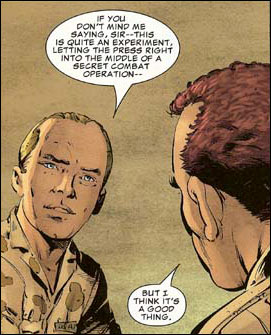comics
 “In our attempt to bring this story [about the war in eastern Congo to access gold deposits] to the attention of these international gold traders, Human Rights Watch and I worked together to create an exhibit of my mining photographs in Geneva, Switzerland, where Metalor Technologies, one of the leading gold mining companies, has its corporate offices. We invited to the exhibit’s opening night gold buyers and mining company executives as well as financiers, stockholders and journalists. Immediately after seeing this exhibit, Metalor Technologies halted its purchases of Congolese gold.…
“In our attempt to bring this story [about the war in eastern Congo to access gold deposits] to the attention of these international gold traders, Human Rights Watch and I worked together to create an exhibit of my mining photographs in Geneva, Switzerland, where Metalor Technologies, one of the leading gold mining companies, has its corporate offices. We invited to the exhibit’s opening night gold buyers and mining company executives as well as financiers, stockholders and journalists. Immediately after seeing this exhibit, Metalor Technologies halted its purchases of Congolese gold.…At about the time I was teaching these young students, I was collaborating with a comic artist, Paul O’Connell, on an article for Ctrl.Alt.Shift. Our partnership revolved around the idea of us combining our various skills to create new ways of delivering messages. What this meant is that Paul took my photographs from places like the Congo and transformed them into a comic strip to tell the story to a different audience.” (via)
Grassroots Comics

“Almost any issue, idea or fact can be expressed in a comic. This kind of visual storytelling is flexible, attention-grabbing and relatively inexpensive.”
World Comics is a non-profit organization in Finland and India that promotes the use of local comics as a means for social change. Grassroots Comics: A Development Communication Tool (PDF) is a free, downloadable manual for other non-governmental organizations about developing comics with community activists for use in their campaigns. See examples of grassroots comics in India and Africa, as well as videos and posters from grassroots comics workshops.
Domestic Policy
Another item I missed while out, on May 24, President Bush appointed Karl Zinsmeister as his chief domestic policy advisor (replacing Claude Allen who resigned in February when caught stealing from Target.) Judging from the appointment, the domestic agenda seems more about propaganda than poverty.
His qualifications? Zinsmeister was editor of The American Enterprise, the magazine of the American Enterprise Institute, a neo-conservative think tank whose stated mission is to support the “foundations of freedom — limited government, private enterprise, vital cultural and political institutions, and a strong foreign policy and national defense.” Among the organization’s funders are both Microsoft and the Scaife family.
Also on his resume, in 2003, Zinsmeister was embedded as a military reporter with the 82nd Airborne in Iraq. His Iraq experience is chronicled in Combat Zone: True Tales of GI’s in Iraq, which Zinsmeister wrote for Marvel Comics. [source] The comic excludes accounts of torture and detainee abuse by the 82nd Airborne later documented by Human Rights Watch.
Further qualifying him, is Zinsmeister’s 2002 essay When Art Becomes Inhuman, a critique of modern art, liberals, and, of course, Manhattan. [source]. His rant against abstraction is an ironic reversal from the days when the CIA helped promote abstract expressionism at the expense of social realism to keep the Commies at bay. Nowadays, with abstraction duly en-framed in the canon of modern art, it makes easy fodder for the ‘liberals are elitist snobs’ line of right-wing populists.
Among his accusations, is one about lefty directors of musical theater who “believe audiences should absorb ideological messages in the theater, not beautiful songs.” This is of course coming from his own ideological screed. But it’s also a further note of just how ideological the apparent ‘invisibility’ and ‘neutrality’ of beauty really is.

Road Kill
Courtesy of Ken Avidor:
 “Highway expansion in America is big business. The Highway Expansionists enjoys the support of both Democrats and Republicans and sometimes Greens. Millions of dollars are spent on propaganda to support the notion that the destruction of the People Zone for the Auto Zone is an inevitable and desirable part of “Progress.” If you add the billions of dollars the auto and oil industry spends on advertising and public relations, it is no wonder that opponents of highway expansion face a public wall of apathy and suspicion. It is not easy to break through that wall of conditioning. Words alone cannot correct the positve mental images people have of automobiles and highways from acquired from a lifetime of viewing TV commercials.
“Highway expansion in America is big business. The Highway Expansionists enjoys the support of both Democrats and Republicans and sometimes Greens. Millions of dollars are spent on propaganda to support the notion that the destruction of the People Zone for the Auto Zone is an inevitable and desirable part of “Progress.” If you add the billions of dollars the auto and oil industry spends on advertising and public relations, it is no wonder that opponents of highway expansion face a public wall of apathy and suspicion. It is not easy to break through that wall of conditioning. Words alone cannot correct the positve mental images people have of automobiles and highways from acquired from a lifetime of viewing TV commercials.
STRIDE (Southside Traffic Reduction Initiative to Determine our Environment) uses photos, art and comics on its website to counter the industry PR images. Comics and satire are also a fun way to convey complex ideas. They can also attract attention to more serious stuff. We are hoping to add music and animation to the STRIDE site in the near future.
These are some sites that have art and comics against highway expansion [in Minnesota]:
http://www.Stride-mn.org
http://www.roadkillbill.com
http://www.andysinger.com
http://www.carbusters.org/
Psyops Comics IV: Viet Nam

“Honey, what do they say in those leaflets?”
“They are the same as those wall posters, as well as the announcements on the radio yesterday. The two Communists Ba Luong and Hai Gon are presently hiding our village in order to collect taxes. I am determined to report to the Phoenix Operation Committee because I know their hiding place.”
We’ve seen the CIA use comics to fight the Sandinistas; the FBI to fight the Black Panther Party; and with the Comics Code Authority to portray the CIA, ethnic advancement agencies, and the economically privileged in a positive light for U.S. comics readers. The CIA also used comics during the Vietnam War as part of its psychological operations and counterinsurgency campaign.
The comic book, “Mr. Ba’s Family and the Phoenix Operation,” was prepared and disseminated by U.S. forces in South Viet Nam under Operation Phoenix. Operation Phoenix was designed to assassinate or imprison members and collaborators of the National Liberation Front, the united front that brought together Communists and non-Communists to liberate Viet Nam from foreign control.
“Phoenix offices were set up from Saigon down to the district level. Their functions were to: (1) collate intelligence about the ‘Vietcong Infrastructure’; (2) interrogate civilians picked up at random by military units carrying out sweeps through villages; (3) ‘neutralize’ targeted members of the NLF. This third task was often carried out by CIA-led Vietnamese organized into Provincial Reconnaissance Units.”
The comic the fictional story of “Mr. Ba,” who is conviced and eventually rewarded for informing the U.S. military about where the Viet Cong are hiding in his village.
Read more about the comic or See pages from the comic and an English translation. Note, the page and images load slowly.)
On July 19, 1971, William Colby, the CIA officer in charge of Operation Phoenix, testified before a Subcommittee of the House Committee on Government Operations, that between 1968 and May 1971, 20,587 alleged Vietcong sympathizers were executed as a result of the Phoenix Program. The government of South Vietnam credited Phoenix with 40,994 deaths. Vietnamese who were taken into custody were often tortured before being executed. U.S. military-intelligence officer, K. Barton Osborn testified that none of those ever held for questioning lived through the process. (New York Times, August 3, 1971, p. 10.)
The Memory Hole has posted a collection of CIA documents from the Phoenix Program online.
Murals and Anti-Murals in Nicaragua
Two years ago I spent my birthday in Nicaragua. I was traveling with a delegation organized by Peaceworks, meeting with local groups and learning about the country and its struggles. As the eight of us bounded along the dusty roads in the back of a white pickup truck, one could periodically spot these odd abstract murals along walls and fences. They were vertical, horizontal, and diagonal stripes in pastel colors. It turns out the stripes had been painted over Sandinista slogans and murals under orders from right-wing President Arnoldo Aléman. See Nicaraguan Murals 1930-2000 on the Stanford site for a hint of what was lost.
The painted stripes reminded me of Sol LeWitt and Sean Scully. A fizzy gallery world rhetoric of geometry instead of engagement with the world at large. And that’s just the way the CIA likes it. From the Monthly Review:
“[The] CIA and its allies in the Museum of Modern Art (MOMA) poured vast sums of money into promoting Abstract Expressionist painting and painters... What the CIA saw in Abstract Expressionism was an ‘anti-Communist ideology, the ideology of freedom, of free enterprise. Non-figurative and politically silent it was the very antithesis of socialist realism’. They viewed Abstract Expressionism as the true expression of the national will. To bypass right-wing criticism, the CIA turned to the private sector (namely MOMA and its co-founder, Nelson Rockefeller, who referred to Abstract Expressionism as ‘free enterprise painting.’)”
See also articles in Salon and the New York Times.
Needless to say, the CIA also poured of money, weapons, and comics into toppling the Sandinistas.

 We rode through the streets paved with hexagonal ‘Somoza bricks’ crumbling from the wear and tear. The Somoza government had laid the bricks, having purchased them from factories he also owned.
We rode through the streets paved with hexagonal ‘Somoza bricks’ crumbling from the wear and tear. The Somoza government had laid the bricks, having purchased them from factories he also owned.
These stark blue billboards were everywhere. “Obras No Palabras” painted in the same yellow italic sans serif and listing some local government financed project. “Works not Words,” a kind of anti-propaganda propaganda promoting the good will of the State and attempting to short-circuit debate.
And indeed, Aléman’s works have spoken loudly. This past September, Nicaragua’s Attorney General charged Aléman and 13 members of his family and former administration “with money laundering, fraud and other crimes.”
I bet he never saw that coming from his own former vice-president.
Archie Loves Betty, Veronica, and the FBI
Since 1954, the Comics Magazine Association of America has issued a Comics Code Authority Seal to comics submitted by publishers which meet the standards of the Comics Code. In practice, the Code was used as a tool of censorship, since it was nearly impossible to sell unapproved comics to newstands and mass merchandisers. With the rise of specialty comic book stores in the mid-80’s, most publishers have opted out of the Comics Code.
The code was updated in 1971 and again in 1989. The 1989 version adds:
“In general, recognizable national, social, political, cultural, ethnic and racial groups, religious institutions, law enforcement authorities will be portrayed in a positive light. These include the government on the national, state, and municiple levels, including all of its numerous departments, agencies and services; law enforcement agencies such as the FBI, the Secret Service, the CIA, etc.; the military, both United States and foreign; known religious organizations; ethnic advancement agencies; foreign leaders and representatives of other governments and national groups; and social groups identifiable by lifestyle, such as homosexuals, the economically disadvantaged, the economically privileged, the homeless, senior citizens, minors, etc.”
CPB notes, “DC Comics and Archie are the publishers who still abide by the Code to portray the CIA, ethnic advancement agencies and the economically privileged in a positive light.”
Learning to Trust Democracy with Comics
“The outcome of an exemplary peace and democratisation process in South Africa was dependent on the success or failure of its founding Election Day. In the end, the new democracy emerged clearly victorious, which was seen by many observers to be a ‘miracle’. But this miracle can be explained against the backdrop of media involvement in a large-scale pedagogical undertaking that was probably the most massive national communication campaign of all time.”
“The ‘Our Time To Choose’ comic book was designed by the Storyteller Group for the Institute for a Democratic Alternative for South Africa.” From openDemocracy.
page 2 1


